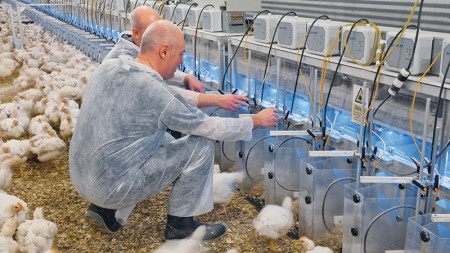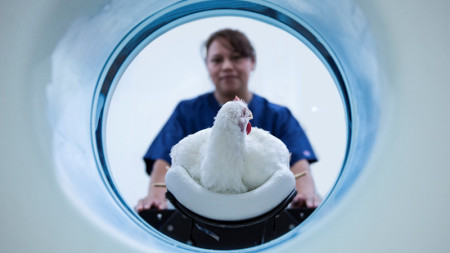Breeding a sustainable future: balanced genetic selection optimized with genomics
By Geneticist Eduardo Souza, Vice President of Research and Development, Aviagen, Inc.
In a world working to feed a growing population while minimizing environmental impact, balanced genetic selection is essential.
The core of our approach is to balance bird productivity, welfare, environmental sustainability, and economic success. We do so through innovative genetic selection practices enriched with genomic tools.
Decades of progress in welfare, performance and efficiency
 Over the past two decades, broiler genetics has seen remarkable progress. In the 2000s, at 42 days, a typical chicken weighed 2.3 kilograms, with a feed conversion ratio (FCR) of 1.91. Fast forward to 2020, the same chicken now weighs 3.1 kilograms, with an FCR of 1.64. This advancement translates to an annual weight gain of 40 grams, a 1.3-point FCR improvement, and a 0.3% increase in meat yield each year.
Over the past two decades, broiler genetics has seen remarkable progress. In the 2000s, at 42 days, a typical chicken weighed 2.3 kilograms, with a feed conversion ratio (FCR) of 1.91. Fast forward to 2020, the same chicken now weighs 3.1 kilograms, with an FCR of 1.64. This advancement translates to an annual weight gain of 40 grams, a 1.3-point FCR improvement, and a 0.3% increase in meat yield each year.
These improvements benefits poultry producers economically and environmentally. Better feed conversion reduces feed consumption and enhances nutrient efficiency, reducing waste materials like nitrate and phosphate and lowering greenhouse gas emissions. Genetic improvement in feed conversion translates to a reduction in poultry's carbon footprint at 1% per year. Today's broiler chickens produce 50% less carbon footprint than those from the 1970s, with a further 15% reduction anticipated by 2030.
Genetic potential with genomics
 Genomic, the use of the DNA information for predicting genetic potential, has revolutionized broiler genetic selection. Genomic data allows us to assess genetic potential with greater accuracy to identify birds with superior health, welfare, and performance characteristics, resulting in a more robust and productive flock.
Genomic, the use of the DNA information for predicting genetic potential, has revolutionized broiler genetic selection. Genomic data allows us to assess genetic potential with greater accuracy to identify birds with superior health, welfare, and performance characteristics, resulting in a more robust and productive flock.
Genomics uncovers unique bird qualities. For example, it enables more precise selection decisions for traits like egg production or hatching potential in males which previously relied only on family information from female relatives. Genomic selection improves the accuracy of the breeding value up to 50%, especially for traits with low genetic variability. It complements traditional methods, providing valuable information for the selection process. We are now able to discern each bird's genetic configuration and specific inheritance from its parents, driving performance improvement across generations and ultimately improving performance broiler production.
Leveraging genetic innovation
 Sustainability remains a driving force in our industry. At Aviagen, we use technology like real-time feed conversion sheds and radio frequency identification transponders to collect and analyze feed data on individual birds. Complex statistical models predict bird genetic potential, helping us select efficient and robust birds. Improved FCR not only contributes to environmental sustainability, but also bolsters economic efficiency by lowering feed costs.
Sustainability remains a driving force in our industry. At Aviagen, we use technology like real-time feed conversion sheds and radio frequency identification transponders to collect and analyze feed data on individual birds. Complex statistical models predict bird genetic potential, helping us select efficient and robust birds. Improved FCR not only contributes to environmental sustainability, but also bolsters economic efficiency by lowering feed costs.
Over 15 years, to produce a 2.5-kilogram chicken, the genetic gains in FCR have reduced feed consumption by half a kilogram and the need of water by one liter. Improved feed efficiency conserves water and require less land usage. The ultimate goal is to produce more food with fewer resources, ensuring a sustainable and environmentally responsible approach to poultry farming.
Multidisciplinary approach
Today's efficient broiler chickens result from collaboration among geneticists, nutritionists, management specialists, and veterinarians. Together, they deliver high-quality breeding stock to producers, enabling them to feed consumers worldwide.
Genetic selection is vital to achieving balance in productivity, animal welfare and environmental sustainability. Long-term investments in R&D allow for sustained genetic improvement, which translates in a continuous improvement in poultry production worldwide. Our commitment to sustainability enables producers to feed a growing global population with nutritious and healthy chicken meat.